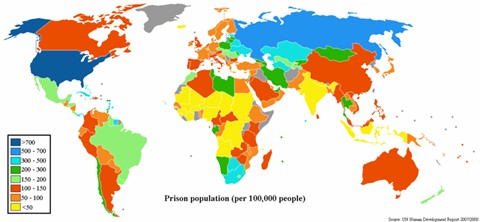
Upon being presented with the map above, the first question that pops to most minds is, “Why is the incarceration rate in the United States so absurdly high?” But given our proclivity for the esoteric, we now find ourselves wondering, “Why is the incarceration rate in Indonesia so darn low?”
There is certainly no single, all-encompassing answer to that head-scratcher. There’s probably something to be said for the law-abiding nature of most Indonesians, perhaps buttressed by the importance of tight-knit families living in relatively small communities. But we suspect a big part of the answer may be the legal system’s grudging tolerance for vigilante justice, especially in areas where the police hold little to no sway. A fascinating 2006 piece on the extrajudicial killings of “sorcerers” in Java ends with this disturbing coda:
Throughout Java not only sorcerers, but also alleged wife-beaters, thieves, rapists, and so on are often violently targeted by local residents. Neighbours, family, and friends form groups to punish the accused. This can be a spontaneous reaction to an incident, but equally the measure may be planned. The violence is specifically targeted against the accused. Even if the spouse and children support or protect the accused, they are often left untouched. The punishment is summary and violent, with the corpse often being defiled. The authorities often sympathise and turn a blind eye to the punishment.
Community justice is taken for granted. Aside from pointing to the alleged wrongdoing, the participants barely articulate, rationalise, or systematically explain their actions. Yet this ad hoc, sometimes spontaneous, and frequently violent form of justice is pervasive and entrenched. No account of justice in Indonesia would be complete without analysing it.
We suspect that as Indonesia’s central government becomes more robust in the coming years, its tolerance for such community justice will diminish—which, in turn, will require the greater use of incarceration. That may not sound like a happy prospect, but no healthy democracy can allow vigilantism to rival the state. We here in the U.S. know all too well where unchecked “community justice” can lead.


Jordan // Dec 1, 2009 at 12:02 pm
A while back I found an amazing online collection of lynching postcards. The sheer volume of material and the size of the crowds often seen in the postcards boggles the mind.
http://www.withoutsanctuary.org/main.html
Brendan I. Koerner // Dec 1, 2009 at 12:54 pm
Great minds think alike–that’s the link off the post’s final two words. Mind-boggling, indeed.
Captured Shadow // Dec 1, 2009 at 12:55 pm
Indonesia has a fairly high level of corruption in the police too, which might explain some of the low incarceration rate.
jackal // Dec 1, 2009 at 5:26 pm
Similarly, in India, police in Mumbai are (in)famous for ‘encounters’ — basically extrajudicial killings of mobsters etc. since the legal system is so slow. ‘Encounter specialists’ are even celebrated by the media..